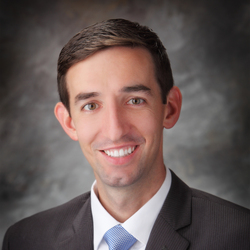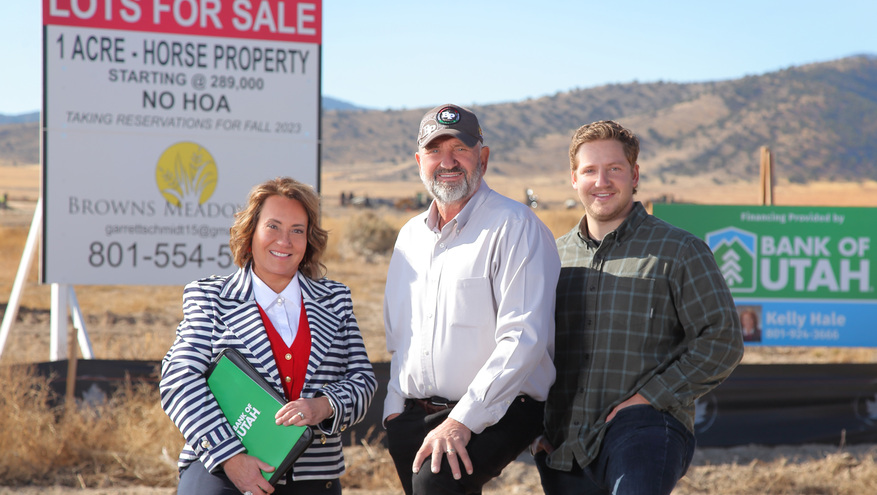In 1952, my great-grandfather, Frank M. Browning, started Bank of Utah not because he wanted to build a big financial institution, but because he wanted to build something local, personal and lasting. He believed that a handshake still meant something; that people bank with people, rather than buildings or brands; and that when you know someone’s name, their kids’ names, and what they’re trying to build, you’re doing more than managing money. You’re helping your neighbors pursue what matters most, whether that’s a home, a business or a legacy.
That belief has never left us. If anything, it’s grown stronger over the years, and during Community Banking Month, it’s a good reminder of what makes banks like Bank of Utah different: the way we focus on relationships.
I’m often reminded of that difference in the conversations I have with people who’ve worked with our team. At a recent conference, someone shared how much they appreciated the experience they had with us — not because of the outcome, but because of how they were treated. They told me, “I felt like your team genuinely cared about helping me reach my goals. I left with clarity, encouragement and the confidence to move forward. I’ll definitely be back.”
That moment stuck with me. Being a community bank means listening closely, offering honest guidance and supporting people through every stage of their financial journey. It means treating every conversation as the start, or continuation, of a long-term relationship rather than a one-time transaction.
That kind of experience isn’t the exception; it’s what we aim for every day. It’s one example of why relationships are still at the heart of what we do. Here are four reasons relationships continue to matter to everyone we serve, and to us, too.
4 Ways Strong Relationships Support Clients and Communities
1. They Build Trust That Lasts
When you know your banker, and your banker knows you, something powerful happens. Trust takes root. You don’t have to explain your story every time you reach out. Over time, we begin to recognize your patterns, understand your priorities and anticipate what you need. That kind of familiarity creates space for honest conversations and timely guidance, grounded in a real relationship.From there, the conversation naturally shifts from day-to-day needs to bigger-picture goals. Whether you're launching a business, refinancing your home or planning for retirement, we’re here to think through the “what ifs” with you, and offer thoughtful advice that helps you move forward with clarity and confidence.
We’ve helped families open a child’s first savings account and, years later, walked with them through retirement or succession planning. That kind of continuity builds confidence in your plan and in the people supporting it. You don’t build that relationship overnight. But when it’s there, it changes everything, from everyday decisions to how you shape your future.
2. They Help You Make Smarter, More Personalized Decisions
At larger banks, decisions can feel impersonal. At Bank of Utah, we’re able to weigh context alongside numbers, applying sound judgment and practical insight rooted in real relationships. When we work with clients we know well, we can tailor solutions to fit real-world needs, whether it’s adjusting timing, rethinking structure or exploring options that others might not even consider.That kind of understanding allows us to be both thoughtful and creative. We can align recommendations with a client’s timing, risk tolerance or growth stage. Because we’ve taken the time to get to know our clients, we’re better at seeing the full picture, and at making decisions that reflect both their current needs and long-term goals.
This kind of flexibility allows us to uphold high standards while serving people in a way that’s personalized, responsible and responsive. It’s one of the reasons clients continue to place their trust in us, year after year.
3. They Make You Feel Seen and Supported
Banking can be intimidating, especially if you’ve ever felt like just another number or application in a queue. But that’s not how it should be. When you have a relationship with your banker, you gain more than financial services. You gain a trusted person in your corner.At Bank of Utah, our team members take the time to listen, ask the right questions and offer encouragement along the way. At a recent bank-wide meeting, three of our bankers shared how meaningful it is to truly know their clients — to greet them by name when they walk in, ask about their families and celebrate their milestones. That’s the kind of connection we strive for: not surface-level service, but real relationships built on familiarity and care.
Whether someone is navigating a major life change or simply learning to manage their finances for the first time, we’re committed to meeting them with understanding, thoughtful support and a focus on their success. That kind of support is what makes community banking personal. And in a world that’s moving faster every day, a little personal connection goes a long way.
4. They Strengthen the Entire Community
In the hands of a community-focused bank, relationship banking has the power to multiply impact.When we help a small business grow, that creates jobs. When we approve a mortgage, we’re helping someone build a future in their own neighborhood. And when we work with city leaders or nonprofits, we’re reinvesting in the places we all call home.
At Bank of Utah, we believe that strengthening communities is simply part of good banking. It’s work we’ve been doing since 1952, through lending, investing and volunteering in ways that create lasting impact. Many of these efforts also happen to qualify under the Community Reinvestment Act (CRA), which helps recognize and track how financial institutions serve their communities. For us, it’s more than meeting a requirement, it’s about living up to our mission.
That mission shows up in many ways. In 2024, our team members contributed nearly 1,600 service hours to 77 organizations across the state, supporting financial education, career training and vital services for families in need. It also shows up in quieter ways, like the local taxes we contribute, which help fund public services, including education here in Utah.
Community banks like ours serve clients and communities. And when relationships are strong, communities thrive.
The Enduring Power of Local, Personal Banking
The banking world is changing fast, but our values aren’t. Since our founding, relationships have been the foundation of our growth. They help us stay grounded during economic shifts, because we understand our clients' real-world challenges and can respond with care and clarity. They help us adapt to new technology with purpose, ensuring every tool we build serves real people with real needs. And they help us meet our clients’ evolving needs, because we take the time to understand what matters — by listening.
Most importantly, they’re what make us a true community bank. My great-grandfather, Frank M. Browning, built this bank on the belief that banking should be personal, local and lasting. More than 70 years later, we’re proud to carry that vision forward, showing up for our clients, our communities and each other — this month and every month.
Your Financial Story Matters — Let’s Talk
Stop by your local Bank of Utah branch during Community Banking Month. Whether you’re planning your next big step or simply want to work with a banker who truly knows you, we’re here to help you move forward — together.
The photo featured at the top of this post shows one of Bank of Utah's own: Kelly Crane-Hale, SVP team leader and commercial lender, with her clients Howard and Garrett Schmidt. Their partnership is a great example of what community banking can do. You can read more about it here.
 Ben Browning is Chief Executive Officer and Vice Chairman of the Board at Bank of Utah. From a young age, Ben knew he wanted to be a banker, inspired by his family’s legacy and the meaningful relationships at the heart of community banking. With a background in finance, business strategy and leadership development, he’s committed to preserving those values while guiding the bank’s continued growth and innovation. He lives in Northern Utah with his wife and their three children.
Ben Browning is Chief Executive Officer and Vice Chairman of the Board at Bank of Utah. From a young age, Ben knew he wanted to be a banker, inspired by his family’s legacy and the meaningful relationships at the heart of community banking. With a background in finance, business strategy and leadership development, he’s committed to preserving those values while guiding the bank’s continued growth and innovation. He lives in Northern Utah with his wife and their three children.




